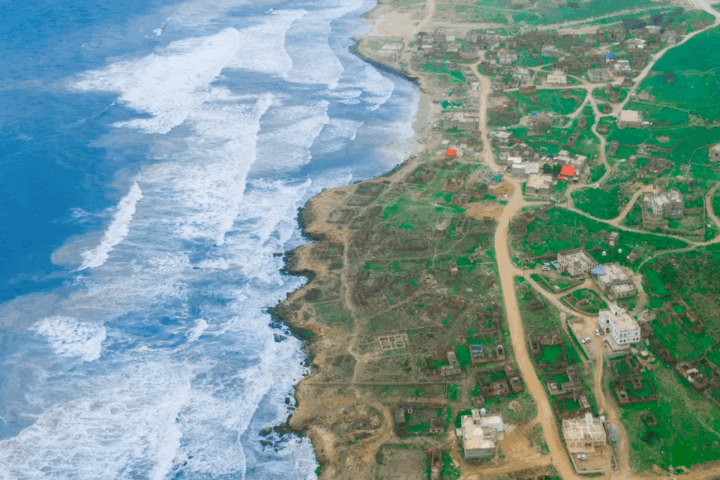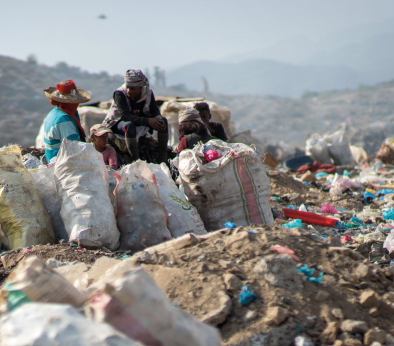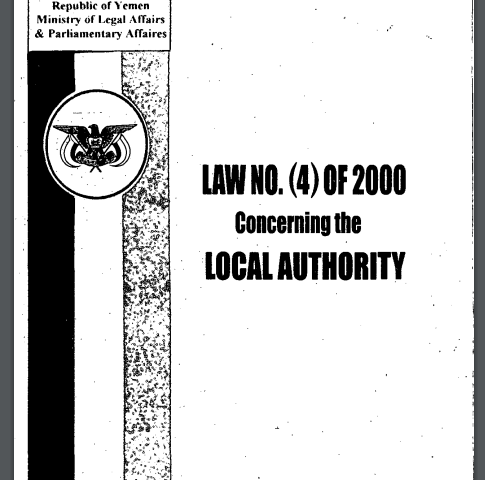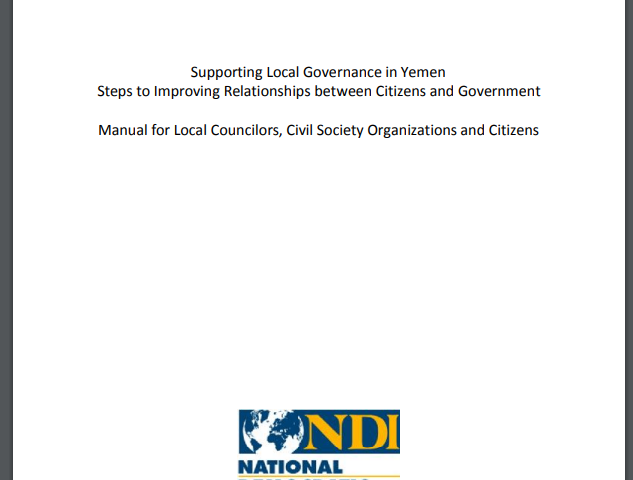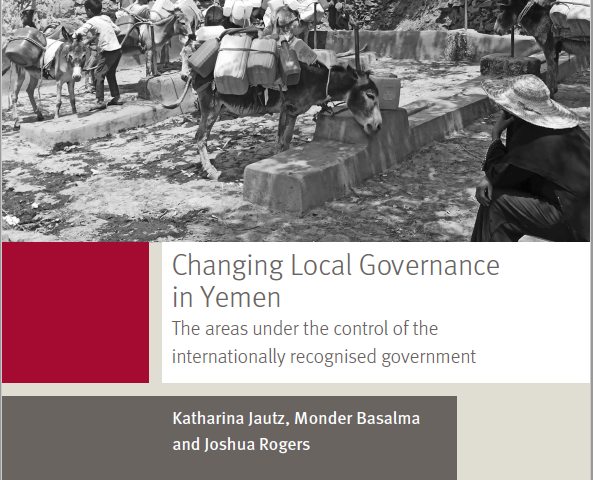The governorate of Al-Mahra, sometimes called the ‘eastern gateway’ of Yemen, is located in the far southeast of Yemen on the border with the Sultanate of Oman along approximately 500 kilometers of Arabian Sea coast. It is located 1,318 kilometers east of Sana’a. The governorate is the least populous in Yemen. It is divided into nine administrative districts and Al-Ghaida, its capital, is a coastal town on the Arabian Sea.
Al-Mahra governorate information
Map of Al-Mahra
Economy
Agriculture, livestock breeding, and fishing are the primary economic activities in Al-Mahra. A number of crops are cultivated in the governorate, the most important of which are vegetables. The governorate is located along an approximately 500 kilometer long stretch of coastline, which provides access to rich fisheries. The Port of Nashtoun, in particular, is an important center of fishing and fish export.1https://www.yemenna.com/index.php?go=guide&op=show&link=mahra. Al-Mahra is famous for its myrrh and incense, and aromatic resins remains an important export to the Gulf countries. Preliminary studies show the presence of minerals, including gold, marble, granite, and black sand, in the governorate, though none are currently being exploited.
In 2014, the local authority derived 94% of its revenues from grants and central subsidies and 6% from local revenues.2Please see the appendix for further information on these different types of revenue. The most significant local revenues were local shared resources, revenues from sales of products and services, and taxes, especially on income, profits, and products and services.3Republic of Yemen, Ministry of Finance, Budget Sector: estimated local authority budget for the 2014 fiscal year.
The central government continues to pay salaries in Al-Mahra, but operational expenses have been cut by 75%. Despite the disruption in central government subsidies, the local authority in Al-Mahra has maintained its income from local revenues. As Al-Mahra is far from the conflict front lines, it has suffered minimal disruptions to economic life and the government continues to pay regular salaries and to cover the operational costs of the governorate. In addition, the governorate covers the investment budget for service provision and infrastructure maintenance, electricity, water and sewage, as well as other public services.4Wadhah al-Aulaqi, Majed al-Madhji, Local Governance in Yemen Under The Conflict and Instability, Sana’a Center for Strategic Studies, July 2018, p. 23.
The total estimated public revenues of the local authority in the governorate were 24.3 billion Yemeni Riyal, while spending was estimated at 24.6 billion Yemeni Riyal, including 12.5 billion Yemeni Riyal of investment in more than 500 projects. These investments represent the local authority’s attempt to build on the relatively rapid growth Al-Mahra has experienced since the beginning of the war, as its peripheral location, long a source of neglect, has become an asset.5https://almashhadalaraby.com/news/68449
Al-Mahra’s distance from the armed conflict means that it has not experienced an economic decline or loss of revenue on the same scale as elsewhere. However, the fallout from cyclone “Luban” and a long history of central government neglect means that business as usual in Al-Mahra is stability at a precarious level. The poverty rate in the governorate, according to the Household Budget Survey for 2014, was 57.8%.
Local governance
Al-Mahra’s local council comprises 18 members and the governor. There is one vacant seat. The local council has been partially suspended since the war broke out despite the fact that the governorate is far from military confrontations. The local council has not been meeting regularly, but it does convene when necessary. It held a session under the chairmanship of the governor at the end of 2017 to discuss the outcomes of a visit by the Prime Minister to the governorate, in addition to other issues, including the closing accounts of the governorate for 2016.6Yafe’a News Website: http://www.yafa.news/archives/280292. Date: 29 March 2019. It also met to adopt the 2019 budget for the governorate in a meeting on 8 February 2019.
The administrative board of the council continued to perform its functions initially, but it has been largely dormant since the end of 2017.7Golden News website, “Governor of al-Mahra presided over the periodic meeting of the administrative board of the local council in the governorate”. http://golden.news/articles/13268/. Date: 29 March 2019. The executive offices in the governorate are all present and functioning. They are supported and funded by the local authority, in addition to support given from donor countries and organizations.8Badr Basalamah, Local Governance in Yemen; Challenges and Opportunities, Berghof Foundation Operations gGmbH, Germany, May 2018, p. 9. The UAE, Saudi Arabia, and Oman all support specific local projects in the governorate. The local administration has hired new contractors to meet increased demands for services from IDPs and returnees from Saudi Arabia.
Access to basic services
According to OCHA’s 2023 Humanitarian Needs Overview Yemen, there are approximately 100,000 people in need of assistance in Al-Mahra, which constitutes approximately 50% of the population. Fifty-seven percent of them are in dire need.9https://data.humdata.org/dataset/yemen-humanitarian-needs-overview, 2023 People in Need in Yemen The current IDP population of Al Mahra is nearly 17,000 (status December 2022).10Ibid. The tropical cyclone “Luban,” which struck the southeastern coast of Yemen on 14 October 2018, displaced more than 3,000 families, killed three people, and injured more than 100. Floods caused by the typhoon destroyed or contaminated wells and disrupted access to food, medicine, and other basic goods.11USAID, Yemen – a compounded emergency situation, Factsheet No. 1, 2019 fiscal year, 19 October 2018, p. 2. As a result, the governor of Al-Mahra declared the coastal areas a disaster zone and called on the government and international organizations to provide much needed support. In response, a number of agencies and donor organizations stepped in.12OCHA, Yemen: Typhoon Luban, an urgent updates report No. 1, October 15, 2018. In addition, the governorate is home to IDPs fleeing from the fighting in other governorates.
In general, the governorate suffers from a shortage of services. The general situation and services deteriorated markedly after cyclone “Luban” made landfall and led to power outages, fuel shortages, and interruptions in the education and healthcare sectors. Already before the cyclone, Al-Mahra had suffered from a severe weakness of health infrastructure.13Al-Mahra Post website, Sons of Al-Mahra suffer from shortages of services and doubt promises by the local authority and the coalition, 27 March 2018. https://almahrahpost.com/news/349#.XJ4tcFXXKM8. Date: 29 March 2019. Health services are provided at a bare minimum through hospitals and health centers with financing from the local authority and funds provided by some Gulf countries, notably Oman14Weeqayah Press website: http://weeqayah.net/3796/. Date: 29 March 2019. and Saudi Arabia, and support from a number of donor organizations.
In terms of education, schools do not appear to have been affected by the war.15OCHA, An Overview of the Humanitarian Needs in Yemen 2018. No buildings were reported damaged by fighting and teachers are receiving regular salaries.16Economic and Social Development In Yemen Newsletter (Issue No.30, December 2017) published by the Economic Studies and Forecast Sector in the Ministry of Planning and International Cooperation. Financial stability in the governorate has allowed the education sector to operate with minimal disruptions.
Cyclone “Luban” caused severe damage to the Fawry and Jaza’a water projects’ generators, pumping stations, and the water supply network of the capital city of Al-Ghaida. The Public Water and Sanitation Corporation in Al-Ghaida and the local authority worked to restore the operations of the water wells of Al-Jaza’a in October 2018.17Aden News website: The Water Corporation’s branch has successfully restored 65% of the operations in Al-Jaza’a water supply in Al-Ghaida – Al-Mahra, 20 October 2019. http://adennews.net/yemen-50705. Date: 1 April 2019. The water corporation and the Rural Water Authority in Al-Mahra have been expanding access to potable water with funding from the local authority and donors, including several water projects in various districts funded by the Kingdom of Saudi Arabia.18The Media Center of the Governorate of Al-Mahra’s website: https://es-la.facebook.com/pg/mcalmahrah/posts/. Date: 29 March 2019.
Demographics
| District | Size (km2) | Population (Female) | Population (Male) | Population (Total) |
|---|---|---|---|---|
| Shahan | 8,778 | 2,250 | 3,617 | 5,867 |
| Hat | 19,303 | 2,325 | 3,131 | 5,456 |
| Hawf | 1,531 | 4,251 | 5,412 | 9,663 |
| Al-Ghaidhah | 7,159 | 23,941 | 33,179 | 57,120 |
| Man’ar | 17,279 | 4,535 | 5,516 | 10,050 |
| Al-Masilah | 6,806 | 9,584 | 10,625 | 20,209 |
| Sayhut | 2,667 | 10,178 | 12,400 | 22,578 |
| Qishin | 3,485 | 9,755 | 13,159 | 22,915 |
| Huswain | 1,843 | 9,401 | 12,346 | 21,747 |
| TOTAL | 68,851 | 76,220 | 99,386 | 175,606 |
Figures are based on the 2021 Humanitarian Needs Overview Yemen, OCHA. Population figures include the number of IDPs and residents.


